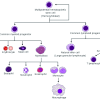A prolonged outbreak of Pseudomonas aeruginosa in a neonatal intensive care unit: did staff fingernails play a role in disease transmission?
Abstract
OBJECTIVES: To describe an outbreak of Pseudomonas aeruginosa bloodstream infection (BSI) and endotracheal tube (ETT) colonization in a neonatal intensive care unit (NICU), determine risk factors for infection, and make preventive recommendations.
DESIGN: A 15-month cohort study followed by a case-control study with an environmental survey and molecular typing of available isolates using pulsed-field gel electrophoresis.… Read more
